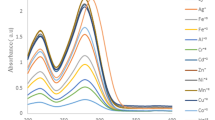Abstract
The present paper firstly announces the possibility of using a Schiff base as an acid-base indicator. This surprising phenomenon can be considered as an interest due to the fact that Schiff bases are usually unstable in solutions and definitely undergo hydrolysis. It was found that such a specific observation depends merely upon the chemical structure and type of the substitute of amine that reacts with aldehyde to give the Schiff base. The latter reagent 4[(4-dimethylamino-benzylidene)-amino]-benzene sulfonamide was synthesized from the condensation of sulfanilamide with p-dimethylaminobenzaldehyde. The reagent solution shows a reproducible change in its color due to the addition of acid and base. A UV-Vis spectroscopic characterization and acid-base equilibrium study of the reagent for its possible use as an indicator were investigated. The results show that the reagent is an amphoteric which possesses four ionization constants Ka1, Ka2, Kb1 and Kb2 of weak dibasic and diacidic properties. The value of pKa2 (9.80) is parallel to the observed transition interval pH 9.5 (yellow) and pH 10.5 (colorless), which is considered to be the indicator exponents pKi. It was concluded that the benzyl sulfonamide group plays a key role in the stability of the reagent towards hydrolysis and also for indicator characteristics through breaking the conjugation.
Similar content being viewed by others
References
R.A. Khalil, B.Z. Al-Khiro, J. Chin. Chem. Soc. 53 (2006) 637.
R.A. Khalil, A.M.A. Saeed, Colloids Surf. A 289 (2007) 206.
R.A. Khalil, A.M.A. Saeed, J. Chin. Chem. Soc. 54 (2007) 1099.
R.A. Khalil, R.Z. Al-Khayat, Physics Chem. Liquids 46 (2008) 34.
R.A. Khalil, R. Al-Hamdany, Dirasat 25 (1998)100.
R.A. Khalil, Raf. J. Sci. 11 (2000) 40.
R. Alonso, E. Dominguez, R. Jimenze, C. Laborra, J. Martinez, F. Vicente, J. Chem Research (M) (1989) 1162.
H. Rossootti, The Study of Ionic Equilibria: An Introduction, Longman, London, 1978.
A.K. Yatsimirsky, N.T. Yatsimirakaya, S.B. Kashina, Anal. Chem. 66 (1994) 2232.
J. Hine, Physical Organic Chemistry, McGraw-Hill Book Company, USA, 1962.
CRC Hand Book of Chemistry and Physics, 55th ed., CRC Press, USA, 1974.
R.T. Morrison, R.N. Boyd, Organic Chemistry, 3rd ed., Allyn & Bacon, Inc. USA, 1973.
E. Banyai, E. Bishop (Ed.), Acid-Base Indicators, in the Indicators, Pergamon Press, Oxford, 1972, and references therein.
L.K. Masly, M.N. Umetskaya, A.A. Tikhomolov, T.N. Timofeeva, Zh. Anal. Khim. 28 (1983) 120.
Author information
Authors and Affiliations
Corresponding author
Rights and permissions
About this article
Cite this article
Khalil, R.A., Jalil, A.H. & Abd-Alrazzak, A.Y. Application of a Schiff base derived from sulfanilamide as an acid-base indicator. JICS 6, 345–352 (2009). https://doi.org/10.1007/BF03245844
Received:
Accepted:
Issue Date:
DOI: https://doi.org/10.1007/BF03245844




